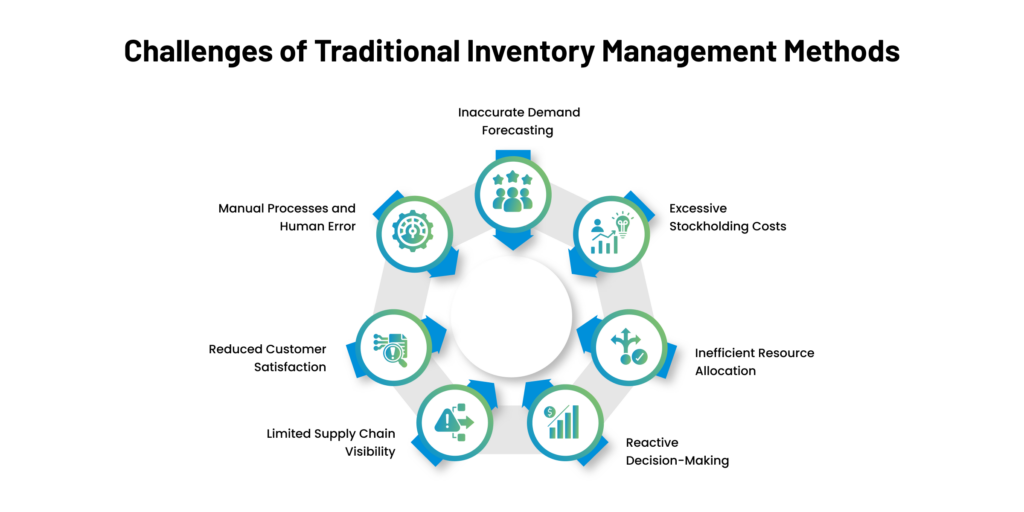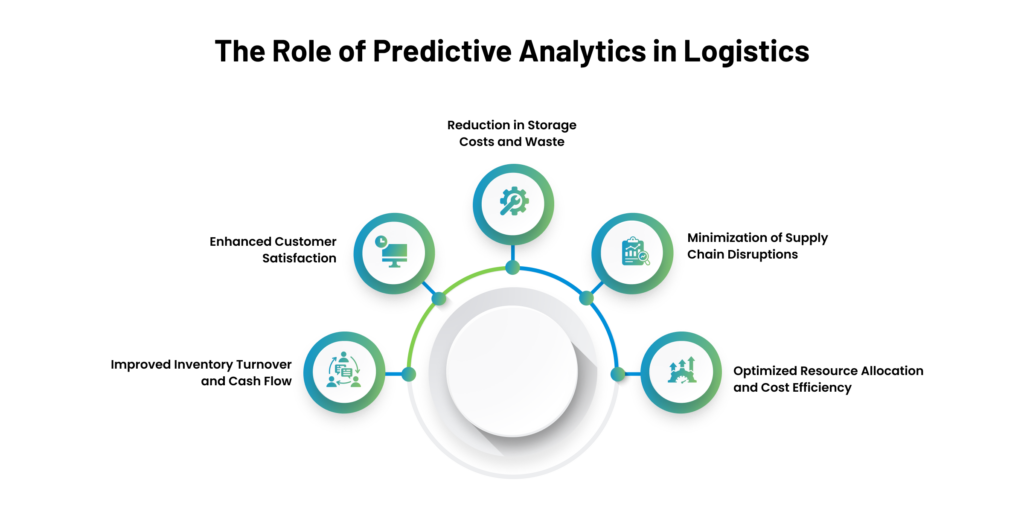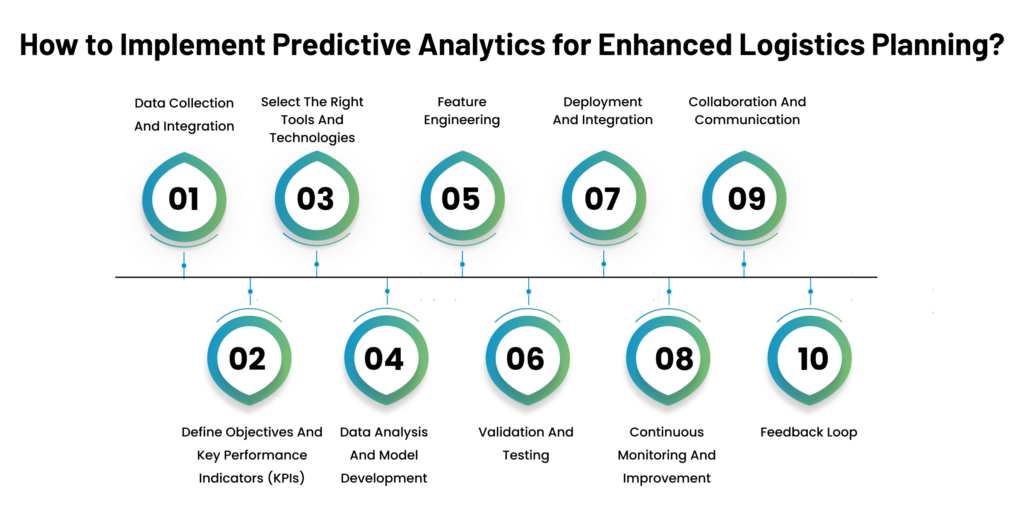In the dynamic realm of logistics, predictive analytics stands as a formidable asset, reshaping how businesses optimize inventory and refine demand planning. Unlike traditional methods, which often rely on historical guesswork, predictive analytics harnesses data-driven insights and advanced algorithms to forecast market shifts and customer preferences.
By analyzing intricate patterns within vast datasets, predictive analytics empowers businesses to make informed decisions, ensuring optimal stock levels and agile supply chains. Considering historical data and external variables like economic indicators and social trends, its forward-looking approach equips companies to adapt to changes and capitalize on opportunities proactively.
In this blog, we will delve into the transformative impact of predictive analytics on inventory optimization and demand planning in logistics. From the mechanics behind these insights to real-world applications, let’s understand how predictive analytics reshapes the landscape of efficient and effective logistics management.
Also, Read – How Supply Chain Digitization Drives Agility and Resilience in Industry 4.0
Challenges of Traditional Inventory Management Methods
While once the backbone of supply chain operations, traditional inventory management methods often struggle to keep pace with the complexities of today’s dynamic business landscape. These methods, relying on historical data and manual decision-making, are fraught with challenges that hinder operational efficiency and profitability.
Here are some of the critical challenges posed by traditional inventory management methods:

Inaccurate Demand Forecasting
Traditional methods heavily rely on historical sales data and trends to forecast future demand. However, this approach overlooks external factors such as market fluctuations, emerging trends, and shifts in consumer preferences. Businesses often need to be more accurate in demand forecasts, leading to overstocking or stockouts, adversely impacting revenue and customer satisfaction.
Excessive Stockholding Costs
When you store too much stuff in your inventory, it can end up costing you quite a bit. Think about things like storage space, insurance, and the fact that items can lose value over time (depreciation).
Usually, old-school methods are all about playing it safe. They pile up inventory just to make sure they never run out of anything. But the downside is that it ties up a lot of money in those extra goods. That can put a damper on your cash flow and limit the funds you have available for other important parts of your business. So, it’s kind of like having your money stuck in a storage room instead of using it where you need it most.
Inefficient Resource Allocation
Traditional inventory management often needs more granularity for efficient resource allocation. With real-time insights into demand patterns and inventory levels, businesses can optimize production and distribution processes, leading to suboptimal utilization of resources, increased lead times, and higher operational costs.
Reactive Decision-Making
When businesses don’t have predictive insights, they decide on the fly. They’re often caught off guard by sudden changes in demand or supply chain hiccups, which puts them in firefighting mode and leads to rushed decisions, much stress, and missed chances to tackle problems before they become significant issues.
Limited Supply Chain Visibility
Traditional methods provide limited visibility into the intricacies of the supply chain. This lack of transparency prevents businesses from identifying bottlenecks, inefficiencies, and opportunities for improvement. The absence of real-time data integration hampers the agility required to adapt to rapidly changing market conditions.
Reduced Customer Satisfaction
Inaccurate demand forecasting and inefficient inventory management directly impact customer satisfaction. Stockouts frustrate customers and drive them to competitors while overstocking can lead to product obsolescence and increased markdowns. Striking the right balance between supply and demand is crucial for maintaining high customer service levels.
Manual Processes and Human Error
Traditional inventory management methods often involve manual data entry and calculations. This consumes valuable time and introduces the risk of human error. Inaccurate data can cascade through the supply chain, leading to costly mistakes and operational disruptions.
The challenges of traditional inventory management methods are increasingly pronounced in today’s fast-paced business environment. The inadequacies of relying solely on historical data and manual decision-making processes hinder businesses from achieving optimal inventory levels, cost efficiency, and customer satisfaction.
As the supply chain landscape evolves, adopting advanced predictive analytics and data-driven solutions becomes imperative for businesses aiming to thrive in this competitive era. How? Let’s understand.
Also, Read – How Smart Preventive Maintenance Transforms Operations in Manufacturing
The Role of Predictive Analytics in Logistics
Efficient inventory management has long been a cornerstone of successful logistics operations. However, with the evolving complexities of global supply chains and ever-changing consumer demands, traditional methods often fall short. This is where predictive analytics emerges as a game-changer.
By leveraging the power of data analysis and machine learning, predictive analytics redefines inventory management strategies, offering a more precise and proactive approach. Let’s explore how predictive analytics is pivotal in reshaping this critical aspect of logistics.

Improved Inventory Turnover and Cash Flow
Predictive analytics allows logistics companies to break free from the traditional approach of maintaining excessive stock “just in case.” Instead, it provides precise insights into demand patterns and consumer behavior.
By knowing exactly when, where, and how products are needed, businesses can strike a balance between stocking enough to meet demand and avoiding unnecessary overstocking. This optimization leads to improved inventory turnover, swiftly converting products to revenue.
Moreover, optimized inventory levels free up capital that might have otherwise been tied up in surplus stock, positively influencing cash flow and financial health.
Enhanced Customer Satisfaction
Customers today demand not only quality products but also impeccable service. Predictive analytics arm logistics companies with the ability to anticipate customer needs accurately. By analyzing historical data and trends, businesses can predict what customers will likely purchase and when they’ll need it. This translates to reduced instances of products being out of stock or excessive inventory that might result in price reductions. When customers consistently find what they’re looking for when they want it, their satisfaction soars, fostering loyalty and repeat business.
Reduction in Storage Costs and Waste
Warehousing and storage costs can become a significant burden on logistics operations. Predictive analytics addresses this challenge by allowing companies to maintain an inventory that aligns precisely with demand. This means less physical space required for storage, reducing warehousing costs. Moreover, accurate demand forecasting minimizes the chances of products becoming obsolete or expiring on the shelves, effectively cutting down waste and associated disposal costs.
Minimization of Supply Chain Disruptions
In the intricate web of the supply chain, disruptions can send ripples of inefficiency throughout the process. Predictive analytics acts as a proactive shield against such disruptions. Analyzing historical and real-time data identifies potential bottlenecks, delays, or issues in the supply chain. Armed with this foresight, companies can take pre-emptive actions, such as sourcing from alternative suppliers or adjusting production schedules, mitigating the impact of disruptions, and ensuring a smoother supply chain operation.
Optimized Resource Allocation and Cost Efficiency
Logistics involves managing numerous resources, from labor to transportation. Predictive analytics optimizes the allocation of these resources by accurately predicting demand patterns. This allows companies to allocate resources precisely where and when needed, avoiding wastage and inefficiency.
For instance, rush shipments and emergency hiring become less frequent, leading to cost savings. Beyond financial gains, optimized resource allocation contributes to sustainability efforts by reducing unnecessary resource consumption.
With that said, predictive analytics emerges as a game-changer in the realm of logistics inventory management. It’s not just about crunching numbers; it’s about crafting a finely tuned logistical symphony where inventory turnover is optimized, customers are delighted, costs are minimized, disruptions are mitigated, and resources are allocated with precision.
In an era where agility and precision are paramount, predictive analytics empowers businesses to thrive in the dynamic landscape of modern logistics.
How to Implement Predictive Analytics for Enhanced Logistics Planning?
Implementing predictive analytics for enhanced logistics planning involves using historical data and advanced analytics techniques to make accurate predictions about future supply chain activities, enabling better decision-making, resource allocation, and overall operational efficiency.
Here’s a step-by-step guide on how to implement predictive analytics in logistics planning:

Data Collection and Integration
- Gather relevant data from various sources within your supply chain, including transportation, inventory, suppliers, customers, and more.
- Integrate and consolidate data from different systems and departments to create a comprehensive dataset for analysis.
- Ensure data quality by cleaning and preprocessing the data to remove inconsistencies, errors, and outliers.
Define Objectives and Key Performance Indicators (KPIs)
- Clearly define the objectives of your predictive analytics initiative. This could include goals like improving delivery times, optimizing inventory levels, reducing transportation costs, etc.
- Identify the key performance indicators (KPIs) that align with your objectives, such as on-time delivery rate, lead times, inventory turnover, etc.
Select the Right Tools and Technologies
- Choose appropriate analytics tools and platforms that can handle the volume and complexity of your data. This might involve using specialized logistics software or general-purpose data analytics tools.
- Consider using machine learning libraries and frameworks for building predictive models.
Data Analysis and Model Development
- Perform exploratory data analysis (EDA) to understand patterns, trends, and relationships within the data.
- Choose suitable predictive modeling techniques such as time series analysis, regression, classification, clustering, or more advanced methods like machine learning algorithms (e.g., random forests, neural networks).
- Train and fine-tune models using historical data. Utilize techniques like cross-validation to ensure the models’ reliability and generalization capability.
Feature Engineering
- Identify and create relevant features (input variables) for your predictive models. These could include variables like historical demand, weather conditions, holidays, supplier performance, economic indicators, etc.
Validation and Testing
- Split your data into training, validation, and test sets to evaluate model performance.
- Use appropriate evaluation metrics (e.g., mean absolute error, root mean squared error) to assess how well your models predict future outcomes.
Deployment and Integration
- Integrate your predictive models into your logistics planning and management systems. This might involve creating APIs or interfaces that allow real-time or batch predictions.
- Ensure the scalability and robustness of the deployed models to handle changing data and operational demands.
Continuous Monitoring and Improvement
- Regularly monitor the performance of your predictive models using real-world data.
- Refine and update models to accommodate changing trends, seasons, or other factors impacting logistics operations.
Collaboration and Communication
- Foster collaboration between data scientists, analysts, and logistics experts to ensure that predictive insights align with operational realities.
- Communicate the results and predictions effectively to decision-makers and stakeholders to drive informed decisions.
Feedback Loop
- Collect feedback from the implementation of predictive insights in logistics operations.
- Use this feedback to refine and improve the models, data sources, and overall predictive analytics process.
Predictive analytics in logistics planning can lead to improved demand forecasting, better resource allocation, reduced lead times, optimized routes, and enhanced customer satisfaction. However, it’s essential to recognize that successful implementation requires ongoing attention to data quality, model accuracy, and alignment with business objectives.
Remember that the specific steps and tools may vary depending on your organization’s size, industry, and technological capabilities. Regularly review and update your strategies to adapt to changing market conditions and business needs.
Conclusion
In conclusion, implementing predictive analytics for enhanced logistics planning can revolutionize how businesses manage their supply chains and distribution networks.
By harnessing the power of data-driven insights, companies can streamline operations, optimize resource allocation, and ultimately improve customer satisfaction. While the initial setup and integration of predictive analytics may require time and resources, the long-term benefits outweigh the costs.
Further, as we look ahead to future trends in logistics planning and analytics, several vital developments stand out:
Real-Time Data Integration: With advancements in IoT (Internet of Things) and sensor technologies, logistics companies will increasingly rely on real-time data feeds to enhance predictive models. This will enable them to respond proactively to changing conditions and make well-informed decisions.
Artificial Intelligence and Machine Learning: As AI and ML algorithms continue to evolve, logistics planning will become more accurate and efficient. These technologies enable systems to self-optimize and adapt to dynamic market demands, reducing manual intervention and human error.
Predictive Prescriptive Analytics: Integrating predictive and prescriptive analytics will enable logistics companies to anticipate potential issues and recommend the best action to mitigate them. This proactive approach will further improve operational efficiency and cost-effectiveness.
Sustainability and Green Logistics: In response to growing environmental concerns, logistics companies will increasingly adopt predictive analytics to optimize their routes, reduce fuel consumption, and minimize carbon footprints. Sustainable logistics will become a key differentiator in the industry.
Blockchain in Supply Chain Management: Blockchain technology will play a crucial role in enhancing transparency and traceability within the supply chain. By integrating predictive analytics with blockchain, logistics companies can gain real-time visibility into their inventory and ensure goods’ secure and efficient movement.
However, partnering with a reputable digital transformation services company is always advisable to fully capitalize on these trends and stay ahead in the competitive landscape.
Implementing predictive analytics in logistics planning is no longer a distant dream; it is a tangible reality that forward-thinking companies must embrace. By harnessing the power of data-driven insights and keeping a keen eye on future trends, businesses can optimize their logistics operations, reduce costs, and deliver exceptional customer experiences.




